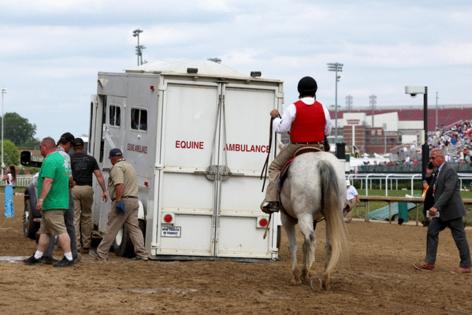A year later, racing is still trying to make sense of Churchill Downs deaths
Published in Horse Racing
LOUISVILLE, Ky. — Last year's Kentucky Derby Day at Churchill Downs saw 143 horses enter the starting gate. Most will remember Mage, who crossed the finish line first in the world's most famous race. But forgotten by all who didn't known them were Chloe's Dream and Freezing Point, who never made it to the finish line, who never made it back to their stall, who were euthanized after suffering life-ending injuries and were the sixth and seventh fatalities in 10 days.
Racing continued at the storied track until the death count reached 12 and racing ceased at Churchill Downs on June 4, when it was moved to nearby Ellis Park for the remainder of the meeting. The Horseracing Integrity and Safety Authority (HISA) issued a 197-page report about the fatalities on Sept. 12. It was filled with charts and graphs and all the things they teach in presentation school. What it didn't have was a singular reason for the rash of deaths.
"It's not like we didn't uncover the causes," said Lisa Lazarus, who runs HISA. "It's that there wasn't one singular factor that caused each of the fatalities. But we did learn a whole lot from the investigation and the data we've been collecting. With that we've been working very closely with Churchill Downs to enhance what was already a very rigorous safety protocol process."
This year has been decidedly different. There have been no reported fatalities as of Tuesday. Whether it is by increased scrutiny, accident or happenstance, it paints the 150th running of the race in a much more favorable light.
Last year's spring meeting was the biggest crisis the sport has faced since 2019, when 36 horses died at Santa Anita Park. The track was closed for three weeks, and an investigation also found no singular cause.
Dr. Will Farmer is the equine medical director for all tracks owned by Churchill Downs Inc. He also worked for the California Horse Racing Board in 2019.
"These were two very different situations," Farmer said. "In 2019 at Santa Anita we had some significant weather, so we had definite factors to be looked at in regard to surface management and weather-related training. It was very different than what we saw at Churchill last year. The factors that were identified with Santa Anita were not in play at Churchill."
Sometimes the deaths just happen in clusters and no one seems to know why. In fact, California had 11 fewer racing deaths and 14 fewer training deaths in 2019 than it did in 2018, but they didn't all happen at the same time.
Was a cluster the case at Churchill Downs last year or Santa Anita in 2019?
"We have seen these somewhat clusters that seemingly don't have a lot of links between them," Farmer said. "They are incredible challenges for us as a regulator and a scientist who likes to have answers. We want to have cause and effect. We want to explain why something happened.
...continued
©2024 Los Angeles Times. Visit latimes.com. Distributed by Tribune Content Agency, LLC.







Comments